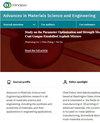不同动态载荷下支承路面声发射事件的数值模拟
4区 材料科学
Q2 Engineering
引用次数: 0
摘要
本文通过数值模拟和理论分析,研究了不同动载条件下支护巷道声发射(AE)事件的分布特征。根据 AE 数值模拟原理,利用 FLAC3D 软件建立巷道模型,通过编辑 Fish 函数建立螺栓拉索支护结构。根据模型动荷载应用准则,引入质点峰值速度、源中心到动冲击破坏点的距离与动荷载强度之间的关系。根据速度-距离-能量关系推导出动荷载能量的大小。模拟结果表明,动荷载源的强度和动荷载源的距离直接影响 AE 事件。动荷载强度越大,离动荷载源越近,AE 事件就越集中。巷道对动荷载应力波的传播有阻挡作用。根据这一特性,可采用高压泄压巷道对巷道进行保护。岩石岩性对动荷载应力波的传播和 AE 事件的数量有很大影响。当动荷载应力波穿过不同岩性的岩层时,动荷载能量的衰减和 AE 事件的数量都很大。然而,当动荷载应力波穿过相同岩性的岩层时,动荷载能量和 AE 事件的衰减较小。巷道底角区域的围岩结构容易受到巷道上方动荷载源的扰动。这些结果对于研究具有扰动型冲击破坏的支护巷道的 AE 特性具有重要意义。本文章由计算机程序翻译,如有差异,请以英文原文为准。
Numerical Simulation of Acoustic Emission Events in Supporting Roadways under Different Dynamic Loads
This paper studies the distribution characteristics of acoustic emission (AE) events in supporting roadways under different dynamic load conditions through numerical simulation and theoretical analysis. According to the principle of AE numerical simulation, the roadway model is established by FLAC3D software, and the supporting structure of the bolt cable is established by editing the Fish function. According to the model dynamic load application criterion, the relationship between the peak velocity of the particle, the distance from the source center to the dynamic impact damage point, and the dynamic load intensity is introduced. The velocity-distance-energy relationship is deduced from the relationship to determine the magnitude of the dynamic load energy. The simulation results show that the intensity of the dynamic load source and the distance of the dynamic load source directly impact the AE events. The larger the dynamic load intensity and the closer to the dynamic load source, the more concentrated the AE events. The roadway has a blocking effect on the transmission of the dynamic load stress waves. According to this characteristic, the roadway can be protected by a high-pressure relief roadway. Rock lithology greatly influences the transmission of dynamic load stress waves and the number of AE events. When the dynamic load stress wave passes through the rock strata of different lithologies, the attenuation of the dynamic load energy and the number of AE events are large. However, when the dynamic load stress wave passes through the rock strata of the same lithology, the attenuation of the dynamic load energy and AE events is small. The surrounding rock structure in the bottom corner area of the roadway is susceptible to disturbance from dynamic load sources above the roadway. The results are greatly significant for studying the AE characteristics of support roadways with disturbance-typeimpact failure.
求助全文
通过发布文献求助,成功后即可免费获取论文全文。
去求助
来源期刊

Advances in Materials Science and Engineering
Materials Science-General Materials Science
CiteScore
3.30
自引率
0.00%
发文量
0
审稿时长
4-8 weeks
期刊介绍:
Advances in Materials Science and Engineering is a broad scope journal that publishes articles in all areas of materials science and engineering including, but not limited to:
-Chemistry and fundamental properties of matter
-Material synthesis, fabrication, manufacture, and processing
-Magnetic, electrical, thermal, and optical properties of materials
-Strength, durability, and mechanical behaviour of materials
-Consideration of materials in structural design, modelling, and engineering
-Green and renewable materials, and consideration of materials’ life cycles
-Materials in specialist applications (such as medicine, energy, aerospace, and nanotechnology)
 求助内容:
求助内容: 应助结果提醒方式:
应助结果提醒方式:


